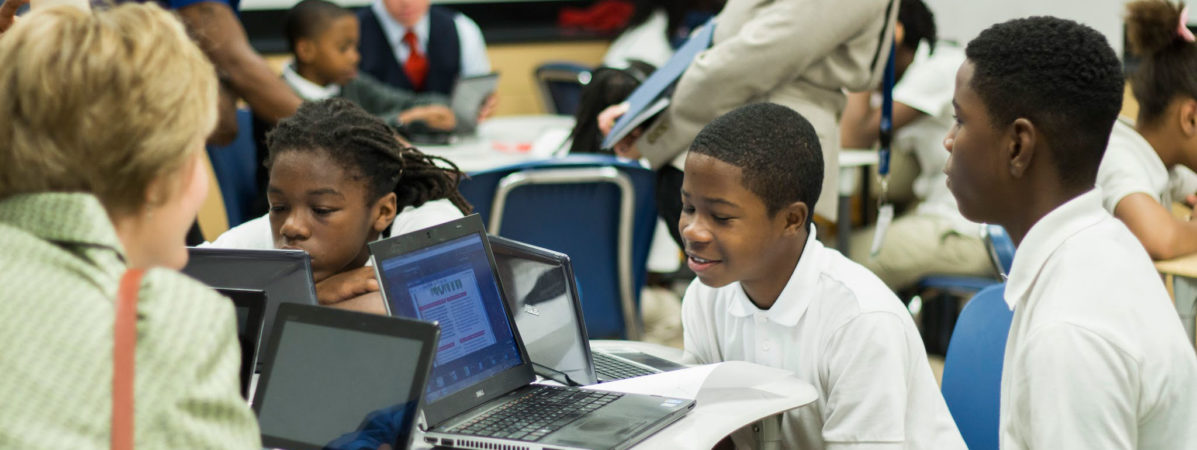
If you want to understand the power of digital learning, just talk to students who are immersed in it.
Students like Shanaiya Paris, a fifth grade student at Ketcham Elementary School in Washington, D.C., who was the tour guide for national school district superintendents, business leaders, and education thought leaders visiting her school for our fall League of Innovative Schools meeting on Monday.
As Shanaiya told me, her teacher, Mr. Bryant, blends online activities with teacher-led instruction, with students getting the support they need based on skill level. Shanaiya liked that she could work at her own pace – often ahead of her classmates, she noted – using online math programs such as i-Ready and ST Math.
It’s one thing to hear this from a school official or a policymaker. It’s another to see a student articulate how these innovative approaches to learning help her succeed. It’s important that all stakeholders’ voices are heard as we work to accelerate innovation in education.
That’s why it was so valuable for us to hear from not only students, but 150 innovative superintendents, school leaders, thought partners, and White House officials at our League meeting, co-hosted by District of Columbia Public Schools.
Looking forward to learning from colleagues across the USA #LISDC @DigitalPromise
— Robert Avossa (@Supt_Avossa) October 5, 2014
Attendees identified the primary challenges standing in the way of innovation in education, developed plans of action, and collectively committed to working on these issues in their cities, states, and districts. They also shared their experience and expertise, learning from one another, as well as students like Shanaiya, throughout the three-day meeting.
Here are three important lessons about digital learning that came out during school visits, workshop sessions, and conversations with White House officials:
1. Thoughtful implementation is essential: Redesigning classrooms to integrate technology is complicated and difficult work and it must be done thoughtfully and deliberatively.
Throughout the meeting, League members emphasized the need for districts to go slowly and get it right when it comes to integrating technology. This approach helps ensure all stakeholders – students, teachers, families, and schools – are prepared to use technology to engage and empower students, superintendents said.
Preparing and supporting teachers is a crucial part of that process. League members identified ongoing teacher support as a top priority and said personalized professional development could help educators increase their effectiveness by meeting the specific needs of each teacher.
Schools and districts will likely make mistakes along the way, but continuously evaluating progress before, during, and after implementing digital learning can help district leaders quickly identify and learn from those mistakes.
2. School districts can’t do it alone: Districts just starting down the path to digital learning can learn a lot from those further down the road. League members using various approaches to digital learning used this week’s meeting to learn from one another, especially D.C. Public Schools, which hosted school visits.
Districts can also partner with community resources – museums, businesses, and colleges – to support digital learning and expand the resources and programs available to students.
Avonworth School District in Pennsylvania, for example, collaborates with neighboring districts Elizabeth Forward School District and South Fayette School District, the state’s department of transportation, museums across Pittsburgh, and professionals throughout the community to enhance student learning.
League of Innovative Schools thought leaders share best practices on digital learning. #LISDC https://t.co/luzmzOxTqY pic.twitter.com/NuS5lDxbxB
— Damian LaCroix (@DLHSSD1) October 6, 2014
This type of collaboration and knowledge sharing is at the core of what the League does, and is the foundation of our biannual meetings. League members work together formally and informally throughout the year, too, sharing best practices in competency-based learning, funding for infrastructure and digital tools, and finding the best learning resources for teachers and students.
We can do more, though, and the members of the League of Innovative Schools are committed to setting an example of what school districts can achieve when they work together.
3. Closing the digital gap is more important than ever: Technology can open the world up to students who might otherwise never know what’s possible outside their hometown. Data and digital tools can also help teachers determine a student’s individual needs and meet them where they are, personalizing learning for every child.
These opportunities can help close gaps that exist between learning outcomes, graduation rates, and college readiness of students based on race, class, and where they live – but only if all students have access.
During this week’s meeting, League superintendents talked with officials from the U.S. Department of Education and the White House Office of Science and Technology Policy about challenges to ensure each student has equal access to digital content at school, as well as at home.
“Only 27% of US schools have even basic connectivity” David Edelman, senior advisor to US CTO. We need public/private investments. #LISDC
— Dr. Steve Webb (@SuptVPS) October 7, 2014
White House officials also talked to League superintendents about resources such as EveryoneOn, a national nonprofit that helps families find low or no-cost Internet options, as well as how to leverage federal programs such as E-rate to fund technology and infrastructure upgrades and take advantage of public and private commitments made as part of President Obama’s ConnectED initiative.
Stay tuned for more to come from the fall 2014 meeting, including resources for schools and districts, a detailed summary of the issues discussed at the meeting, and specific actions the League will take to address those challenges.